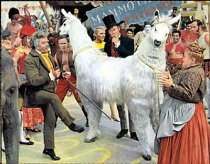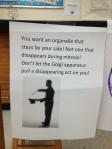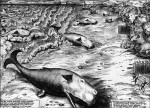Malcolm and I discuss Santas science secrets starting at 1 minute and 8 seconds into this audio clip:
[audio
http://www.brookes.ac.uk/lifesci/runions/DrMolecule/20121218 – Fun ‘facts’ about Santa.mp3]
Once, when Dr. Molecule was younger, he went on holiday in the North and while collecting ice samples from glaciers (which is, oddly, what he does on holiday), he chanced upon a man who he identifies in his notes only as Joe – Joe was collecting ice too, but apparently he only needed ice cubes for his drink. Anyway, below is a small bit (an excerpt) taken from the 3 volume Story of Santa written by Dr. M of which only one copy exists in Joe’s library… (the three dots mean that I could go on but let’s get to the excerpt…)
Excerpt from the 3 volume work – Some interesting mathematical equations explaining how Santa does it.
How does Santa get to all of the boys and girls in a single night? 
That’s a poser.
Using all of my great powers of scientific reasoning, I have been unable to understand all of the technical issues that Santa must overcome to accomplish this enormous task. When faced with a situation that I don’t understand, I consult with the experts and that is exactly what I have done in this situation. For a number of years now, Santa has been working with the people at Really Extra-Incredible North-Pole Dynamics, Ltd. who supply Efficient Expediting with RedNose™ Systems. if you find this is a bit of a mouthful, the company is generally referred to by the acronym REINDEERS.
Doris Elfman (what she lacks in tallness she makes up in brains, I can tell you) is the Chief Scientific Officer of REINDEERS and she was able to help me with some of my questions such as the 5 Hows: How fast does Santa go? How does he fit down chimneys? How does he read all of the letters? How does the sleigh hold so many presents? and How many children get presents?
The most important of the Christmastime technologies is RedNose™ which is like BlueTooth™ except that it’s a different colour. Rednose™ sends out a signal that pinpoints the location of houses with children who are getting Christmas presents. These signals are then mapped to a grid that Santa reads using the SatNav feature of his sleigh. The fantastic thing about RedNose™ is that it also detects cookies and other sweeties that Santa needs to keep him going during the long night of delivering presents – he is a big man, you know!
North Pole scientists have been trying to perfect sleigh guidance tech for a number of years. When BlueTooth™ first came out the lead reindeer was William (Billie) the Blue-toothed reindeer. All of the other reindeer used to laugh and say he looked ridiculous with his tiny-little headset. And that wasn’t the worst thing. Billie was addicted to sugar cubes which are bad for your teeth and caused all sorts of problems with navigation. That is why RedNose™ has now taken over and, these days, the new lead reindeer is Rudy who looks smashing with the RedNose™ receiver unit on his nose.
Santa’s sleigh is a marvel of old-time craftwork, not like modern sleighs with all of the cheap plastic dials. It is necessarily quite large but it still doesn’t look big enough to hold all of the presents. That’s because it is like a Tardis – the adult reading this to you will know what a Tardis is but, basically, it’s bigger inside than outside (ask the adult who else has a Tardis. When they answer, say ‘Who?’ and keep saying that… it makes for endless hours of fun).
There are some interesting sleigh accessories that help Santa. Access to the top of the cargo hold is made easier by ladders provided by the Rose Suchic Ladder Company, and reindeer assist thruster technology is similar to the oscillator caboobillator system used by the car in that old film that you’re probably too young to remember. The SatNav is an advanced version of the one that makes adults use bad language. In early days Santa used to get misdirected… to the South pole once because the wires got crossed. Hover technology is simply a reindeer-assistance accessory that allows the sleigh to take off straight upwards meaning that the reindeer don’t need a long runway. It has voice-activation and Santa used to say ‘hover, hover, hover’ when he wanted the reindeer to take off. As he is a film buff, Santa has shortened the activation command to ‘HoHoHo’ because it reminds him of the ‘Go, Go, Go’ command that one often hears in movies.
All of the battery power in all of the electronic toys provides the vital boost of energy needed to propel the sleigh at such high speeds. That’s why batteries in your toys are often flat on Christmas morning. The effect of emptying the sleigh is that it loses power and has to be shipped home on a specially modified hovercraft which is also activated by saying HoHoHo. Captain of the hovercraft Dave Donnerundblitzen comments, ‘have you ever tried delivering something to somewhere that has a top secret location – that’s why Christmas only happens once a year!’
 Some random musings on Santa himself. Santa looks larger but it’s not the bad kind of overweight – it’s like the water-weight that some adults claim to have. 8 months of the year, Santa basically sits around eating and watching telly. He is awoken from this reverie in about early November when it is time to do the pre-Christmas meet and greet junkets – Santa finds these tiring but acknowledges that it is important to meet kids and talk with them – Mrs. Claus calls this ‘keeping it real’ but I don’t know what she means by that.
Some random musings on Santa himself. Santa looks larger but it’s not the bad kind of overweight – it’s like the water-weight that some adults claim to have. 8 months of the year, Santa basically sits around eating and watching telly. He is awoken from this reverie in about early November when it is time to do the pre-Christmas meet and greet junkets – Santa finds these tiring but acknowledges that it is important to meet kids and talk with them – Mrs. Claus calls this ‘keeping it real’ but I don’t know what she means by that.
Throughout December, Santa slims down by eating Brussels sprouts so that by December 24th he is fighting fit. A little known fact is that chimneys in Brussels are more narrow than normal so it is a good thing they have the spouts. A side effect of eating these is used to heat the sleigh – Santa blames the smell on the reindeer – don’t believe him.
Santa’s red suit uses the old Flannel Red Over-Suit That’s Invisible (FROSTI) technology from the North-Pole Men’s Haberdashery Shoppe (No, I don’t know why ‘Shoppe’ is spelled like that but I suspect it’s because people at the North Pole leave school to work at REINDEERS and never really learn to spell very well). The suit reflects light in a strange way that makes Santa particularly hard to see. What would you do if you could get your hands on a suit like that? Newer versions of these suits use the Camouflage Russet Under-Suit That’s Invisible (CRUSTI) technology but Santa only uses these for underwear.
As well as the hard-to-see red suit, Santa has the big beard. This is surprising in this day and age when men are always shaving with razors that have anything up to 20 blades for a close shave. The reason Santa still has his big beard is simple, duh… it’s so that you don’t recognize him!
How can Santa possibly read all of those Christmas letters? In olden times, letters were delivered to the North Pole by the Post Office. This system is now called snail mail because in some countries they use snails to make the stamps stick. The problem with letters is that people do go on. By the start of December, the North Pole sorting office would be bursting at the seams with great long lists of wishes. It turns out, surprise, surprise, that Santa and his helpers were completely incapable of reading all of the letters. Just ask your adult reader if they ever got something that wasn’t on their list to Santa. I once got a toothbrush (but I digress). To combat the increasing trend towards more and more wishes, the North Pole have recently been moving to an online Christmas letter system in which children are limited to 140 characters when asking for presents. You need to be very succinct! ‘Lalaloopsy Harmony B Sharp’ uses up 26 characters right there – and that’s without saying ‘please’ or ‘thank you’.
 As to who’s been naughty and who’s been nice, all children are basically good (ask the adult who is reading this to you to ‘please keep the eye-rolling to a minimum’. Remember to say ‘please’ because it is important to be polite – and you are, after all, basically good).
As to who’s been naughty and who’s been nice, all children are basically good (ask the adult who is reading this to you to ‘please keep the eye-rolling to a minimum’. Remember to say ‘please’ because it is important to be polite – and you are, after all, basically good).
For Santa to get into your home, a chimney is good but there is a small detail. Most modern homes don’t have big chimneys like they did in the old days. Chimneys these days are either small like in Brussels or non-existent. I know you’re worried about this but Santa uses lots of fancy-schmancy science to get around this problem. One neat little device is made by the Managing Access and Getting In Quickly company based in Northern Norway (This company still doesn’t have an acronym – can you think of one?). The device is called iSanta and is no bigger than a smartphone app. Santa gets that familiar twinkle in his eye when he talks about it. It is well known that if you stick an ‘i’ in front of a normal word then the word becomes turbocharged. Well, when you put an ‘i’ in front of Santa, all sorts of crazy things happen. The device produces a ‘virtual’ version of Santa which is indistinguishable from the real thing and which can project into your home to leave presents (and eat cookies). The only place iSanta can’t project into would be a home completely lined with diamonds (because, obviously, the tight carbon lattice interferes with the signal). Let’s face it though, if your home is completely lined with diamonds, you should be buying the Christmas presents for everyone else! And, no, I don’t know how iSanta works. It’s a heavily guarded technology. If it fell into the wrong hands, anybody could go around leaving presents.
How far and fast does Santa travel? Of course there is a mathematical equation to describe how Santa can possibly visit all of the children’s homes in one night. It looks complicated but I can assure you that it is quite simple really:

I don’t know what the sideways 8 at the end means but I suspect that Santa ‘ate’ and then needed to have a lie down. Otherwise, if you’ll be patient, I think I can explain the rest of this gobbledeegook…
dt means ‘change in time’ and refers to the way Santa can alter time so that the presents all get delivered in one night. A very clever man called Albert once said that if you travel very, very fast – then time slows down for you. Santa uses this principle in reverse – he travels very, very slowly which causes time to speed up for him. Albert isn’t sure why this works but he is content that the world is a weird place. dt equals all of the stuff to the right of the equals sign added up.
Π – This symbol is called pi and means the number 3.14159265359 (memorize that and wow your friends at parties!). It is used in math when circles like the Earth need to be measured. This would come in handy if you were trying to, for example, calculate how far Santa has to travel to deliver all of the presents. In reality though, pi is just in the equation accidentally. It turns out that Santa likes pies (eskimo) and the elf writing the equation misinterpreted what he was saying.
J – This symbol stands for Joule and it means energy – the amount of energy needed to propel Santa’s sleigh at such high speeds. Unfortunately, that same elf writing down the equation wrote J for Joule when Santa actually said ‘jewel’ while finalizing the Christmas present list for Roger Stevens (no, I don’t know what kind of jewel Roger was getting).
Θ is a symbol called theta and a professor would use it to calculate an angle like, for instance, the angles needed for reindeer to speed off at after HoHoHovering.
∑ is a symbol that teachers use to confuse you. It really just means ‘sum’ like when you add things up. Santa was just saying that he would have ‘some’ of Mrs. Clause’s fabulous pie and the elf… well you know what the elf did.
People that know a lot more about math than you and me do have observed that if you squint at the end of the equation you see JΘ∑ – which looks like JOS – and which has historically been the reason that Santa is known as a Jolly Old Soul (I personally think it looks more like JOE and think that Joe is what we should call Santa from now on).
I hope this excerpt helps with some of your questions about Santa and his technology. May you have a jolly holly Christmas and may your house not be lined with diamonds! Hover, Hover, Hover…
If you like this blog, please share it::
Like this:
Like Loading...



























